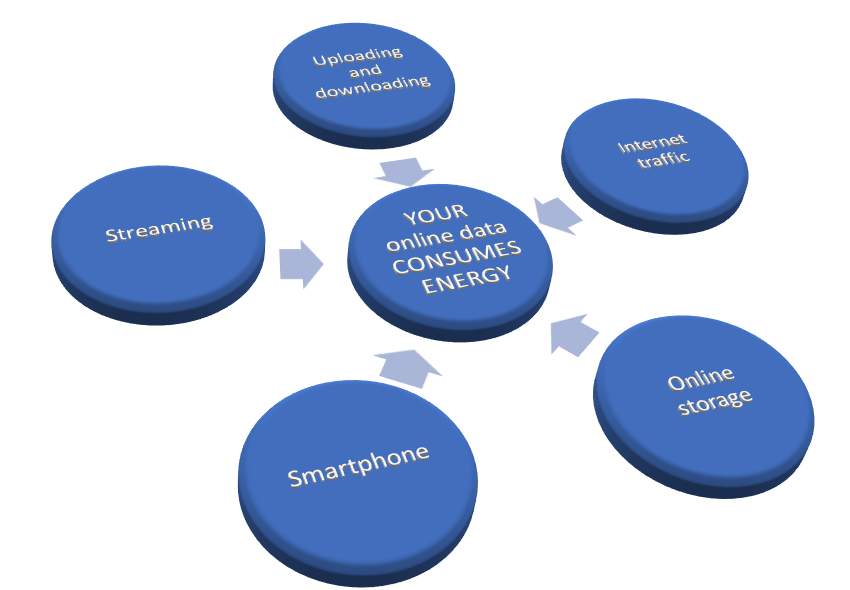A topic that has recently come to my attention is the energy cost of taking and storing a photo and video. On average, a user takes about 900 photos (including unwanted duplicates) in a year according to a report by IET. While the report itself is criticized for the lack of reliable information and the number itself is not important as we all can agree that we take hundreds if not thousands of photos and recordings with our phones, it does outline that factoring the amount of social media data out there (images, videos, posts/text) that it is stored remotely on the cloud (i.e., some remote servers inside huge data farms) impacts energy consumption.
We often talk about sustainability and the IT industry is not an exception. There is an active research field on sustainable or green computing aiming at producing net zero computing, i.e., not producing any carbon footprint from using IT resources. This is different than carbon-neutral which is usually what large cloud data centers do by offsetting their emissions (e.g., they still produce CO2 but they offset it against other initiatives such as planting an equivalent amount of trees elsewhere). The Climate Neutral Data Center Pact is a pledge from key players operating in Europe to reach carbon neutrality by 2030. Large cloud providers such as Microsoft, Google and Amazon have pledged to reach carbon neutrality of net zero emissions around the same time. According to a Microsoft datasheet data centers account for around 0.9% of total greenhouse gas emissions. Although the number seems high considering all our emissions, it is significantly lower than what we produce using on-prem solutions since clouds like Microsoft Cloud can reduce the carbon footprint by as much as 96%. Overall there is an increased use of renewables by these large cloud providers with Amazon reporting that around 90% of its energy came from renewable sources in 2022 and that it intends to be net-zero carbon by 2040. This however does not reduce the impact the average user has on the carbon footprint as every time we use the Internet and the cloud we consume energy that at least in part comes from fossil fuels.
Taking an image or recording a video, accessing the Internet, and posting it requires energy that has to come from somewhere. On your phone you use a battery that recharges from various sources (renewable or not), your Internet connection requires routers and servers that also consume electricity, and finally, the cloud itself requires energy for processing your data and storing it, even when idle. The energy consumption of your media is so high that according to a research paper published in a tier A conference accounts for roughly 60% of all of Facebook’s energy consumption which in 2012 was about 304 GWh. While the article itself is more than 10 years old it does show the stress our habits have on the overall energy consumption. Combined with the fact that we usually access new photos (82% of requests are for new photos) rather than look for old ones it shows that there is a lot of unwanted media trash floating around in the virtual space, all of which takes storage space and consumes unwanted energy.
How much energy is consumed when we upload/download a photo?
While it is difficult to provide universal estimates as the energy consumption depends on the phone, camera, network equipment, and server equipment, I have tried to provide a rough estimate based on scientific benchmarks, information on public websites, and some assumptions. So let us look at the numbers assuming a 5MB image takes 0.3 seconds to upload and 0.8 seconds to download on a 4G network with an upload speed of 18.75 MB/s and a download speed of 6.25MB/s.


The number crunching leads us to about 0.198 Wh (2397 W) for uploading and 0.01 Wh (47.68 W) for downloading the photo. A single LED lightbulb you have in your home consumes between 2-18 W so uploading a photo is equivalent to leaving the light on for 100 hours (or 13 days) while downloading it to leaving it on for 1700 hours (or 10 weeks). Most of it comes from the network that transports the data as seen in the previous images except downloading when a considerable share comes from the phone itself. The International Energy Agency (IEA) provided in 2020 an estimated value in the 0.025-0.23kWh/GB range lower than my estimate for 1 GB of uploaded files: 0.4 kWh. However, the exact energy consumption is impacted by everything (hardware, software, and network) so an exact figure is impossible to determine. A 2018 paper estimated that in Finland the energy consumption would be less than 0.1 kWh/GB by 2020 and that the emergence of small 5G networks will improve energy efficiency.
Storing also consumes energy
Storing 1 GB of data takes about 5 kWh and considering that many of us are using cloud services (including Dropbox, Google Drive, OneDrive, and all the other social media where we post our memories) to store and back up data including photos and movies the value can go as high as 200 GB translating to around 1600 kWh or more than an entire household consumes in a single year!
And we should remember that cloud data is usually automatically backed up somewhere for redundancy by the cloud storage system so whatever you have now can be doubled at least in reality increasing your carbon footprint correspondingly.
What’s next?
Given the relatively small share (about a third) a user has on the overall energy consumption the question is how can she/he be incentivized to take any sustainable action? A simple analysis makes me think about a course of action similar to that which is imprinted in us by the process of selective waste disposal. Maybe in the long term, we need to build a sense of responsibility when using online data including streaming (which for viral popular videos streamed billions of times can consume as much electricity as a small town of 40,000 households). This can partially come from cloud providers that could lower the storage/network thresholds for free accounts and introduce higher prices the more we use to reflect the energy consumption and force users to use less bandwidth.
But we do not need to wait for that. We can simply start storing less data on the cloud. Use portable SSD drives that are relatively cheap and can hold TB of data, or turn off auto-sync for our phone data.



